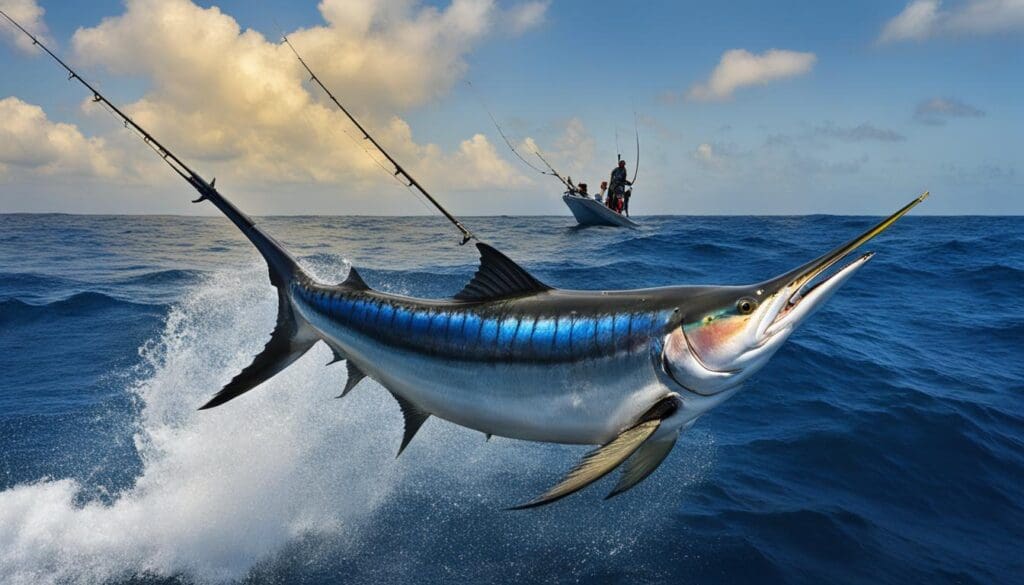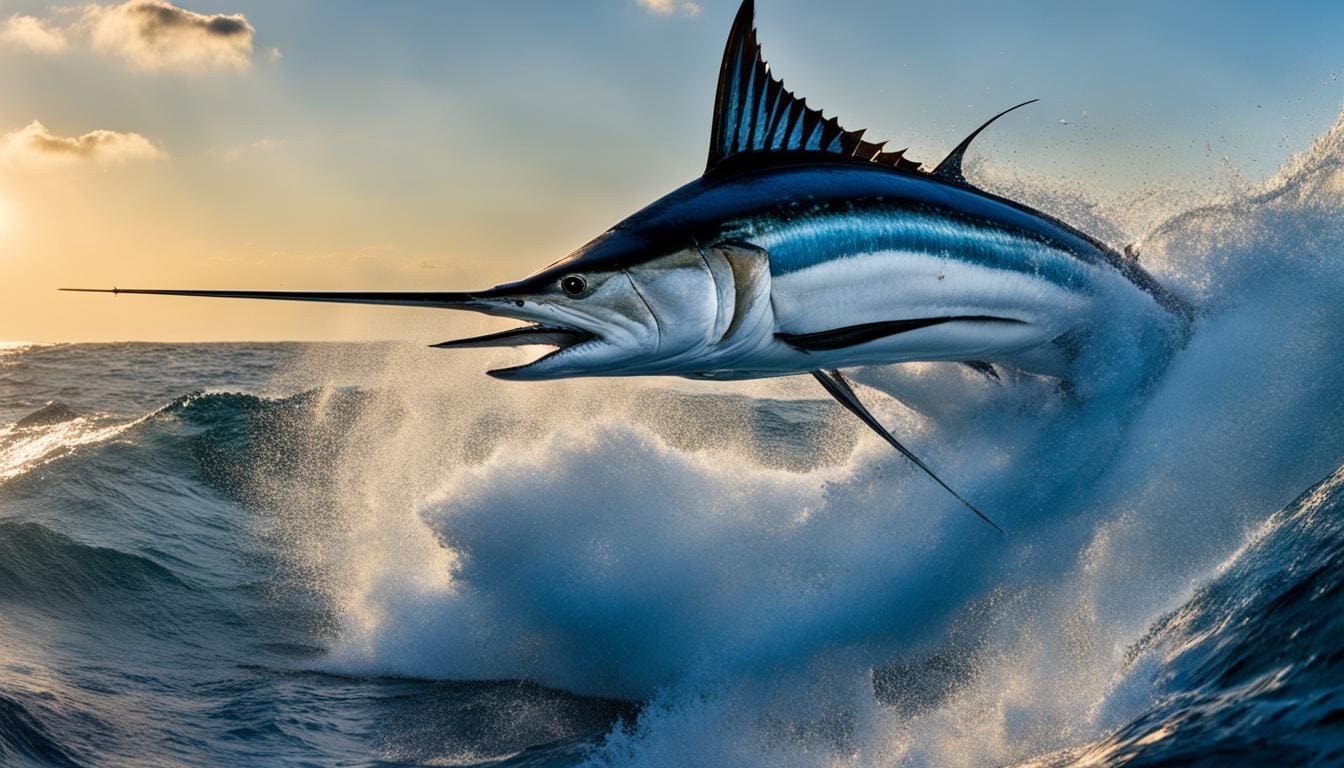Marlin fishing is a thrilling pursuit that attracts anglers from around the world. The thrill of battling these majestic giants of the sea, such as the blue marlin and black marlin, is unmatched. To maximize your chances of a successful catch, it’s important to employ expert techniques and have the right gear at your disposal.
Key Takeaways:
- Mastering marlin fishing techniques is essential for a successful catch.
- The blue marlin and black marlin are apex predators found in tropical and subtropical waters.
- Proper gear and equipment are crucial for marlin fishing.
- Understanding the characteristics and habitats of blue marlin is key to targeting them effectively.
- Knowing the best time of year and the ideal depth for marlin fishing can significantly improve your chances.
Understanding Blue Marlin: Characteristics and Habitat
When it comes to marlin fishing, one cannot overlook the awe-inspiring blue marlin. These magnificent creatures are known for their impressive size and strength, making them a prized catch for anglers around the world. Blue marlin can grow up to 14 feet long and weigh over 1,500 pounds, making them true giants of the sea.
As apex predators, blue marlin hold a dominant position in the marine food chain. They are commonly found in tropical and subtropical waters, thriving in the warm and nutrient-rich environments. These areas provide an abundant food supply for blue marlin, allowing them to grow to such remarkable sizes.
With their striking blue coloration and remarkable power, blue marlin are a sight to behold. Their long, spear-like bills and streamlined bodies enable them to swim at incredible speeds, reaching up to 50 miles per hour. This combination of speed and power makes them a challenging and exciting target for anglers seeking the ultimate fishing experience.
The Habitat of Blue Marlin
Blue marlin are highly migratory creatures, following warm ocean currents and seeking optimal feeding grounds. They are typically found in offshore waters, often venturing far from land. While they can be encountered at various depths, blue marlin tend to inhabit deeper waters, ranging from around 100 to 500 feet deep.
These majestic creatures are well-suited to the open ocean, with their streamlined bodies allowing them to navigate through the water with ease. They are known to frequent areas with underwater structures such as reefs, seamounts, and drop-offs, as these locations provide shelter for their prey and attract a diverse range of marine life.
Understanding the habitat preferences and behavior of blue marlin is crucial for successful fishing. By targeting the right areas and employing the appropriate techniques, anglers can increase their chances of encountering these apex predators and experiencing the thrill of a lifetime.
Blue Marlin’s Favorite Food
When it comes to the diet of a blue marlin, one food stands out as its favorite – flying fish. These apex predators are known to chase and feed on flying fish at the surface of the water. The sight of a flying fish gliding above the waves is a sure temptation for a hungry marlin, triggering a lightning-fast pursuit.
The blue marlin’s preference for flying fish can be attributed to a few factors. Firstly, flying fish are abundant in the same tropical and subtropical waters that the marlin inhabits. Secondly, flying fish have evolved unique adaptations that allow them to glide through the air, making them an easy target for the marlin’s powerful leaps and strikes. Lastly, flying fish provide a nutritious meal for the marlin, as they are rich in protein and fats.
Although flying fish are the blue marlin’s favorite food, it’s worth noting that these apex predators have a varied diet. They are opportunistic hunters and will also feed on other prey, such as squid, mackerel, and other small fish. However, the sight of a marlin launching itself out of the water, chasing a flying fish with incredible speed and agility, is a true spectacle of nature.
| Prey | Description |
|---|---|
| Flying Fish | An abundant prey found in tropical waters. The marlin’s favorite food due to its gliding ability and high nutritional value. |
| Squid | Another common prey for marlin, provides a good source of protein. |
| Mackerel | A small fish often targeted by marlin, rich in oils and omega-3 fatty acids. |
Understanding the blue marlin’s preference for flying fish can be valuable knowledge for anglers looking to increase their chances of a successful catch. By imitating the appearance and movement of a flying fish with the choice of bait or lure, anglers can entice these majestic creatures to strike and engage in an exhilarating battle of strength and will.
Best Time of Year for Marlin Fishing
When it comes to marlin fishing, timing is everything. The best time to catch blue marlin is during the summer months, from May to September, commonly known as marlin season. During this period, the warm waters provide optimal conditions for these majestic creatures to thrive, making it an ideal time for anglers to target them.
Marlin season coincides with the peak of the summer season when offshore waters are calmer, clearer, and teeming with life. This abundance of baitfish attracts blue marlin, as they primarily feed on flying fish, which are plentiful during this time. Additionally, the warm waters offer the perfect temperature for blue marlin to roam and hunt, increasing the chances of a successful catch.
It’s worth noting that marlin season can vary slightly depending on the specific location and prevailing weather patterns. For instance, in some areas, the season may extend into early October or even November. It’s recommended to check with local fishing charters or experienced anglers in your area to get the most accurate information about the timing of marlin season.
| Month | Marlin Activity |
|---|---|
| May | Increasing activity as waters warm up |
| June | Peak season with high marlin activity |
| July | Continued high marlin activity |
| August | Prime time for marlin fishing |
| September | Activity starts to decline towards the end of the month |
As with any type of fishing, success is never guaranteed, but by planning your marlin fishing trip during the summer months, you’ll greatly increase your chances of encountering these magnificent creatures. Remember to check the local regulations regarding marlin fishing and practice responsible catch-and-release techniques to ensure the sustainability of these prized game fish for future generations.
Depth for Blue Marlin Fishing
When it comes to blue marlin fishing, understanding the optimal fishing depth can greatly increase your chances of success. Blue marlin can be found at various depths, but they are typically found in deeper waters, around 100-500 feet deep. This is where they tend to hunt for their preferred prey and where you’re most likely to find them lurking.
One technique that seasoned anglers use to target blue marlin is called “deep dropping”. This involves setting your lines at depths of 200-300 feet or deeper, using specialized rigs and weights to keep your bait at the desired depth. By presenting your bait in the depths where blue marlin are most active, you increase the likelihood of attracting one of these incredible fish.
It’s important to note that the ideal fishing depth can vary depending on factors such as location, time of year, and water temperature. Therefore, it’s always advisable to consult with local experts or experienced anglers to get the most up-to-date information on the best fishing depths for blue marlin in your specific area.
Table: Blue Marlin Fishing Depths
| Fishing Depth (in feet) | Blue Marlin Activity |
|---|---|
| 100-200 | Moderate activity, especially during feeding times. |
| 200-300 | Prime depth range for targeting blue marlin. |
| 300-400 | Potential depth range for blue marlin, depending on conditions. |
| 400-500+ | Deeper depths where blue marlin may venture in search of prey. |
By understanding the preferred depth ranges for blue marlin fishing, you can strategically plan your fishing trip and increase your chances of encountering these majestic creatures. Remember to always prioritize safety and follow local regulations when venturing into deeper waters.
Bait and Lures for Blue Marlin
When it comes to blue marlin fishing, choosing the right bait and lures can significantly increase your chances of a successful catch. Anglers have found success with both live bait and artificial lures, each offering its own advantages and appeal to these powerful predators.
Live bait is a popular choice for blue marlin fishing, with options like tuna or squid being highly effective. Using live bait can mimic the natural movement and scent of the marlin’s preferred prey, attracting them to your line. This method requires careful presentation and proper rigging to ensure the bait is enticing and secure.
Alternatively, artificial lures such as skirted trolling lures can also yield great results. These lures come in a variety of colors and designs, mimicking the appearance of baitfish and enticing the marlin to strike. Trolled at the surface or at various depths, these lures can cover a larger area and attract marlin from a distance.

Comparing Live Bait and Trolling Lures for Blue Marlin Fishing
| Aspect | Live Bait | Trolling Lures |
|---|---|---|
| Realism | High | Variable |
| Presentation | Requires careful rigging | Ready to use |
| Variety | Limited to available baitfish | Wide range of colors and designs |
| Coverage | Localized | Can cover larger areas |
| Attractiveness | Natural movement and scent | Mimics baitfish behavior |
Ultimately, the choice between live bait and trolling lures for blue marlin fishing depends on various factors, including personal preference, fishing conditions, and the targeted area. It’s often beneficial to experiment with both methods to determine which one yields the best results for you. Remember, patience and persistence are key when pursuing these magnificent giants of the sea.
Trolling Speed and Lure Spread
When it comes to blue marlin fishing, trolling speed and lure spread are crucial factors that can significantly impact your success. Trolling speed refers to the speed at which you move through the water while dragging your lures behind the boat. While there is no one-size-fits-all answer, the optimal trolling speed for blue marlin fishing is typically around 8-10 knots. This speed allows the lures to swim naturally and attract the attention of these powerful predators.
It’s important to note that trolling speed can vary depending on various factors, such as sea conditions, lure type, and target species. If you find that you’re not getting any strikes, try adjusting your trolling speed slightly to see if it makes a difference. Paying attention to the conditions and adapting your trolling speed accordingly can greatly increase your chances of hooking a marlin.
Another key aspect of marlin fishing is the lure spread. A lure spread refers to the arrangement and positioning of your lures in the water. Anglers use a spread of lures to cover more water and increase their chances of a strike. A common lure spread for blue marlin fishing is to have multiple lures positioned at different distances and depths behind the boat.
This technique creates an enticing visual display that mimics a school of baitfish, attracting marlins’ attention. By experimenting with different lure positions and sizes, you can determine the most effective lure spread for the conditions and increase your chances of enticing a strike from a marlin.
Remember, trolling speed and lure spread are just two aspects of successful marlin fishing. It’s essential to stay adaptable, experiment with different techniques, and observe the behavior of these magnificent fish. By combining expert techniques with the right gear and understanding of blue marlin’s characteristics, you’ll be well on your way to experiencing the thrill of landing one of these giants of the sea.
Leader and Hook Size for Blue Marlin
When it comes to blue marlin fishing, choosing the right leader and hook size is crucial. These powerful fish require heavy-duty equipment that can withstand their strength and size. Anglers typically opt for heavy monofilament or fluorocarbon leaders with a breaking strength of 150-300 pounds. This ensures that the leader can handle the intense fight that comes with hooking a blue marlin.
Hook size is another important consideration. While sizes can vary depending on personal preference and fishing conditions, 10/0 to 12/0 circle hooks are commonly used for blue marlin. These hooks are designed to minimize injury to the fish and increase the chances of a successful hook-up. Circle hooks are known for their ability to evenly distribute pressure along the fish’s jaw, reducing the risk of the hook pulling out during the fight.
It’s important to remember that the leader and hook size should be matched to the size of the blue marlins you are targeting. Larger fish require stronger leaders and larger hooks to ensure a successful catch. Additionally, always check the regulations and guidelines for the specific fishing location you are in, as there may be restrictions on leader and hook sizes to protect the fish population.
Conclusion
Successful marlin fishing requires expert techniques, proper gear, and an understanding of the fish’s behavior and habitat. By following the right strategies and using the right equipment, anglers can increase their chances of landing these captivating giants of the sea.
To achieve fishing success, it’s crucial to equip yourself with the knowledge of blue marlin characteristics and their favorite food. Knowing where and when to fish, such as during the summer months or at specific depths, can significantly improve your chances of a strike.
Additionally, selecting the right bait and lures, maintaining the appropriate trolling speed and lure spread, and using suitable leader and hook sizes are all essential factors in maximizing your marlin fishing experience. These expert techniques, when combined with a deep understanding of the blue marlin’s behavior, will give you an edge in the pursuit of these magnificent creatures.
FAQ
What is the best time of year for marlin fishing?
The best time to catch blue marlin is during the summer months, from May to September, commonly known as marlin season.
What is the typical fishing depth for blue marlin?
Blue marlin can be found at various depths, but they are typically found in deeper waters, around 100-500 feet deep.
What are the popular bait and lure options for blue marlin fishing?
Popular bait and lure options for blue marlin fishing include live bait such as tuna or squid, as well as artificial lures like skirted trolling lures.
What is the optimal trolling speed for blue marlin fishing?
Trolling speed plays a crucial role in blue marlin fishing, with the optimal speed usually around 8-10 knots.
What leader and hook sizes are recommended for blue marlin fishing?
Anglers typically use heavy monofilament or fluorocarbon leaders with a breaking strength of 150-300 pounds. Hook sizes can vary, but 10/0 to 12/0 circle hooks are commonly used.
How can I increase my chances of catching a blue marlin?
Successful marlin fishing requires expert techniques, proper gear, and an understanding of the fish’s behavior and habitat. By following the right strategies and using the right equipment, anglers can increase their chances of landing these captivating giants of the sea.

